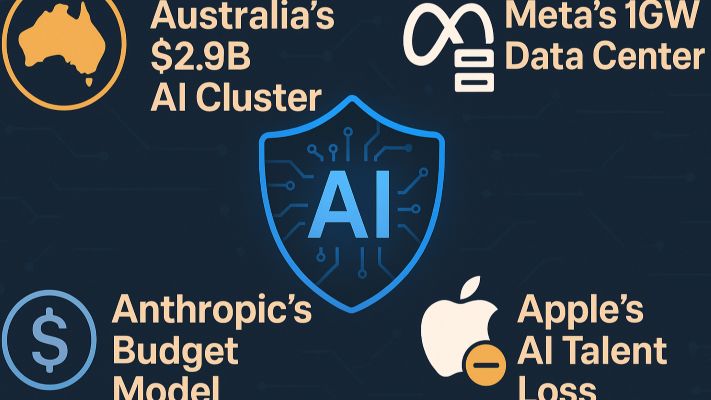AI Navigation
- articleAI Trends
- lightbulb_2AI Tips
- assistant_navigationAI Navigation
- heatHot Articles
- emergency_heat_2Hot Tips
- format_list_numberedPrompt Formatter
- psychologyTest Center(RPI)
October 16, 2025 · 24-Hour AI Briefing: Australia’s $2.9B AI Cluster, Meta’s 1GW Data Center, Anthropic’s Budget Model, and Apple’s AI Talent Loss
As the global AI infrastructure race accelerates, the competition now extends beyond algorithms — into data centers, energy systems, and the battle for top-tier AI talent. From Australia to Texas and Silicon Valley, this week reveals a shifting map of AI power.

1. Australia’s Firmus launches AUD 4.5B renewable-powered AI data center cluster
Australian startup Firmus announced a nationwide expansion project to build one of the largest renewable-powered AI data center clusters in the Southern Hemisphere. The initiative, in partnership with CDC Data Centers and NVIDIA, will cost AUD 4.5 billion (around USD 2.9 billion).
Commentary:
Australia has long lagged in high-performance computing and AI infrastructure. Firmus — backed by CDC’s operational expertise and NVIDIA’s AI hardware ecosystem — represents a turning point. The project emphasizes near-zero water consumption and 100% renewable power, standing out amid rising global energy concerns.
If successfully executed, it could significantly reduce Australia’s reliance on overseas compute, create thousands of jobs, and transform regions like Tasmania and Melbourne into “AI factory zones.”
2. Meta invests $1.5B to build a 1GW AI data center in Texas
Meta announced a $1.5 billion investment to construct a 1GW (gigawatt) data center in El Paso, Texas — equivalent in output to a mid-sized nuclear power plant. The facility will serve as a major compute hub for Meta’s next-generation AI models and infrastructure, set to open in 2028.
Commentary:
This marks Meta’s third major AI facility in the U.S. and reinforces its push toward AI sovereignty by maintaining compute resources on American soil. The 1GW capacity signals Meta’s ambition to transition from a social media company to a full-fledged “AI superintelligence” platform.
3. Anthropic releases Haiku 4.5 — a faster, cheaper compact AI model
Anthropic unveiled Haiku 4.5, a lightweight model offering near-Sonnet 4 performance at one-third of the cost and twice the inference speed. While slightly behind Sonnet 4.5 in programming ability, it significantly reduces deployment costs.
Commentary:
Inference cost and latency remain key barriers to scaling AI applications. Haiku 4.5’s “one-third price, double speed” formula lowers the entry threshold for small and mid-sized enterprises.
While it may not match Sonnet 4.5’s accuracy for precision tasks, its efficiency makes it highly competitive in real-time applications like chatbots, customer service, and embedded devices. However, competition with Google’s Gemini 2.5 Flash will be fierce.
4. Apple’s AI search leader Ke Yang departs for Meta
Ke Yang, Apple’s AI search lead and head of the Siri revamp initiative, is joining Meta. She joined Apple in 2019 and led the Apple Foundation Models team, specializing in AI search and knowledge graph technologies.
Commentary:
Despite Apple’s vast resources and ecosystem, its vertically integrated and hardware-centric culture may have limited innovation flexibility within its AI division.
Ke Yang’s exit marks the latest in a wave of departures — more than 10 senior AI executives have left Apple in 2025 alone. Meta’s aggressive recruitment strategy underlines how the “AI talent war” is intensifying. Yet such moves could also raise antitrust scrutiny around talent monopolization.
The past week shows that AI dominance will no longer be decided by algorithms alone — but by who controls compute power, clean energy, and human capital. The next frontier of AI is not in code, but in infrastructure.
For more AI insights and daily briefings, visit https://iaiseek.com/en
Related reads:
October 15, 2025 · 24-Hour AI Briefing: Microsoft, Alibaba Cloud, and Oracle Accelerate the Global AI Infrastructure Race